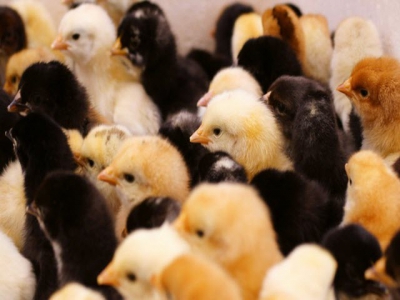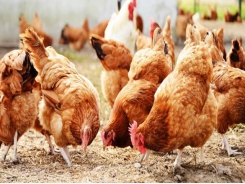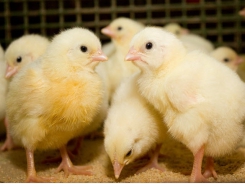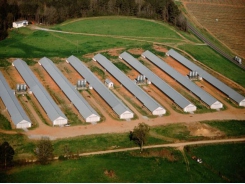Feed type, additive use may help support bird internal ecosystems

Adding coarse grains or supplements are some tools that poultry producers can use to support a healthy ecosystem within birds during early development, says expert.
Photo © GettyImages/ Sergii Kozak
We caught up with Peter Ferket, professor in nutrition and biotechnology at North Carolina State University, during the Amlan International Summer International Poultry Seminar to hear more about his work managing the ecosystem within birds to improve production and gut health.
As researchers and poultry producers have started to avoid the use of antibiotics in poultry production it has become clearer that a bird’s internal ecosystem has an important role, he told us. “Everyone is looking for an alternative product for antibiotics and the reason why we use antibiotics is to control the ecosystem but we didn’t know.”
However, as the use of antibiotics is increasingly limited it is time for producers to start thinking differently about production methods, he said. “My main message is, stop thinking like you’re trying to replace a product, stop think about particular products to do something, you have to start thinking as an ecologist,” he added.
“The message is, think like an ecologist and less like a veterinarian, a nutritionist or a chicken farmer – it’s really a bigger picture,” said Ferket. “Once we understand that then you say, ‘What tools do I use or strategies to activate this stable ecosystem as soon as possible?’”
“It’s an ecology that we have to deal with – that’s the message, rethink your perspective,” he added.
There are three main factors involved with manipulating the ecology within a bird, he said. These include efforts to cultivate a more symbiotic ecosystem, balance nutrition to favor the bird and good bacteria or using production strategies to support a diverse ecosystem while eliminating pathogenic bacteria.
Antibiotic use and ecosystem management
Antibiotics were one way that poultry producers could control the bacterial ecosystem within a bird, said Ferket. There have been several challenges raised by removing most or all antibiotics from use in poultry production.
“We take those out and a pathogen invades, then we have to start using more antibiotics, powerful antibiotics,” he said. “That now starts promoting antibiotic resistance to the very drugs that we count on – it’s counter-intuitive.”
However, antibiotic resistance needs to be considered, because if current practices are not changed and antibiotic use rates continue to expand it could mean major financial loss for poultry producers on a global scale by 2050, he said.
Using multiple tools and thinking about intentionally manipulating the gut health or the bacterial ecology within a chicken or turkey, would give producers the ability to support growth without generating bacteria that are resistant to antibiotics, he said.
“There are strategies, but there is no such thing as an alternative in terms of taking antimicrobials out and putting something else in,” he said during his presentation. In the talk, he also highlighted several of the studies with which he has been involved in attempts to better understand how to influence the gut.
Part of understanding how to modulate the enteric ecosystem looks to improve or mature gut function as quickly as possible, he said. “Right around three weeks is where maturity hits and my goal is to get there by a week,” he added.
Efforts involved in altering the intestinal tract include “seeding” the system with beneficial bacteria, said Ferket. Symbiotic microflora can be supported and used to control competitive organisms or pathogenic bacteria.
One project looked at the development of bacteria within the ceca of turkey before they hatched, he said. Now the process of in-ovo feeding can help birds develop beneficial microflora before they hatch.
Previously, much of that development would have been eliminated when birds were given an early dose of antibiotics, he said.
However, he added in-ovo technology may not be the answer for all producers and can be expensive to scale.
The exploration of the technology also calls attention to the importance of the time window pre-hatch and immediately post-hatch, Ferket said. “As we select birds for faster and faster growth the perinatal period is becoming a greater and greater percentage of their productive life if you consider that the timing the chick is in the egg and the first week after hatch that’s 50% of the bird’s life,” he added.
“If we’re going to focus on the gut and birds’ health, the first few days before hatch and after hatch is the new frontier,” he said.
Producers also could use an in-feed “exclusion product,” like a probiotic, to help support or promote good bacteria development while inhibiting the establishment of harmful bacteria, he said.
“It may actually be competitive for nutrients for some pathogens and so wipes them out, or they might be producing some inhibitory metabolism,” he said of beneficial bacteria growth. “Some produce bacteriocins which could kill off some organisms as well – or compete for cohesion sites or modulate the ecosystems.”
However, there also can be a production cost in the use of a probiotic that has to be considered, he added.
Additionally, poultry feed can be manipulated to simulate gizzard function, which improves nutrient digestion, said Ferket. “The gizzard is the pacesetter for gut motility, and if you can encourage good gizzard function you’ll set up the reverse peristalsis and help maintain these unique ecosystems,” he added.
A study looking at the use of some coarsely ground grain in a poultry diet compared to only finely ground grain in regards of gizzard development found that adding about 8-10% of larger particles in the feed improved function, he said. “We have tested a lot of different things – antibiotic, feed additives, and I’ve never seen anything that profound with so simple an answer as adding more coarse particles in the feed,” he added.
The birds fed the coarser diet had improved feed conversion, larger gizzard size, better nitrogen retention, improved energy use and dryer litter, he said.
Similarly, enzyme use in diets can be a method of both improving nutrient use and a way to support diversity within the intestinal ecosystem, said Ferket. And there has been some interest in finding a way to supplement birds with butyric acid.
“If you get the ceca working right it becomes the primary colonizer, so when an animal becomes sick it will always revert back to that healthy ecosystem,” he said. “If it starts unhealthy it will never get there.”
Có thể bạn quan tâm
Phần mềm

Phối trộn thức ăn chăn nuôi

Pha dung dịch thủy canh

Định mức cho tôm ăn

Phối trộn phân bón NPK

Xác định tỷ lệ tôm sống

Chuyển đổi đơn vị phân bón

Xác định công suất sục khí

Chuyển đổi đơn vị tôm

Tính diện tích nhà kính

Tính thể tích ao hồ




 Mobile system can inactivate avian influenza virus
Mobile system can inactivate avian influenza virus  Novel people movement management technology available for poultry…
Novel people movement management technology available for poultry…